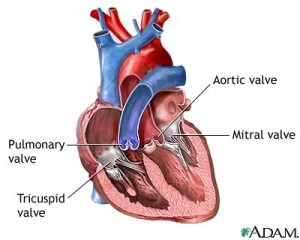Heart Valves – an Overview
The heart consists of four chambers – the right and left atria (upper chambers) and the right and left ventricles (lower chambers). Blood is pumped through these chambers in one direction with the help of four valves, which open and close with each heart beat.
The four valves of the heart:
- Tricuspid valve (separates the right atrium and right ventricle)
- Pulmonary valve (separates the right ventricle and the pulmonary artery)
- Mitral valve (separates the left atrium and the left ventricle)
- Aortic valve (separates the left ventricle and the aorta)
As the heart beats, pressure changes on either side of the valves causing the leaflets, or cusps, to open and close. A properly-functioning valve opens and closes fully. When a valve does not close completely (stenosis), it causes blood to flow through a smaller-than-normal opening. When a valve does not close tightly (prolapse), it can cause backflow (regurgitation) of blood in the heart.

Normal Aortic Valve

Stenotic Aortic Valve
Heart Valves – Conditions and Treatment Options
Some people are born with defective valves (congenital heart defect), which can sometimes be managed with medication. Valves can also become damaged over time due to progression of age, rheumatic fever or infections such as infective endocarditis.
In the case of a mild defect, many patients can be treated with surgical valve repair. This can be achieved through open surgery or minimally invasive surgery. Some of the repairs performed by CTVS surgeons include:
- Commissurotomy
- Valvuloplasty
- Reshaping
- Decalcification
- Structural Repair
- Patching
If a valve is severely defective, a replacement will be necessary. The majority of valve replacements are performed on the mitral valve and the aortic valve, as they are located on the left side of the heart, which works at a higher pressure than the right side.
CTVS surgeons utilize both mechanical valves (synthetic material) and biological valves (valves made from animal tissue or human tissue of a donated heart, also called a homograft) in valve replacement surgery. Mechanical valves are more durable than biological valves, but because blood tends to stick to the valve and cause clotting, recipients are usually required to take blood-thinning medication for the rest of their lives. Biological valve recipients do not require blood-thinning medication in most cases, but there is a chance of valve failure with biologic valves, which could lead to a second operation. Your surgeon will work with you to determine the best methods of management and treatment for your valve condition.
